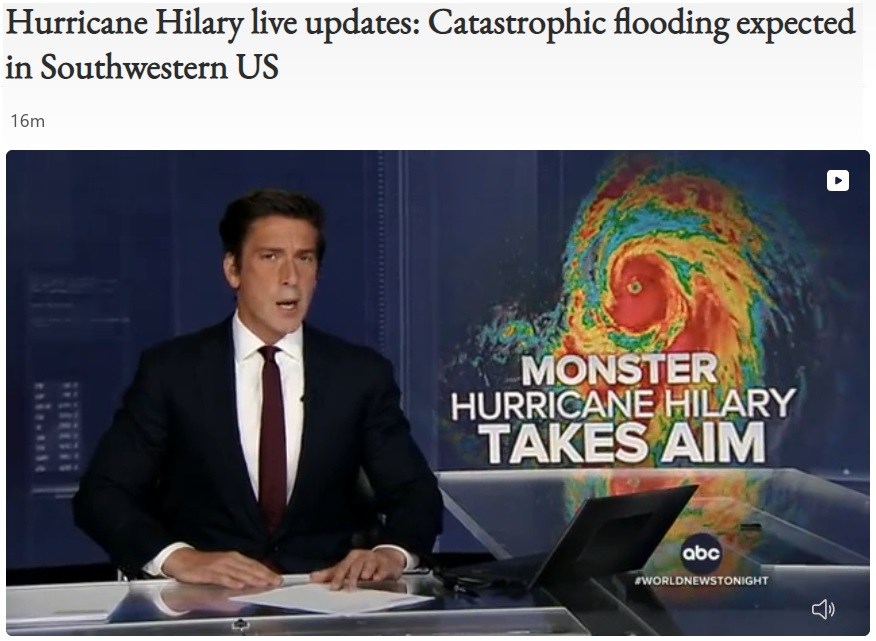by Brian Shilhavy, Health Impact News:

I am writing this Saturday morning, August 19, 2023. I want to make a point of reference to the time, because the news regarding Hurricane Hilary is now changing by the hour.
Last night the corporate media, which collectively all follow a carefully crafted script without much deviation from the narrative they want the public to believe, started using the word “catastrophic” to describe the flooding that is on the way for those living in the Southwest portion of the U.S. in the path of this hurricane, which will be downgraded to a tropical storm either just before making landfall, or shortly after.
TRUTH LIVES on at https://sgtreport.tv/
Having spent many years living in Southern California in the past, and observing over those years how most people who have spent most of their lives living in Southern California where it seldom rains, deal with rain when it comes, which always brings about a huge increase in traffic accidents because people are not used to driving in the rain, I am VERY concerned that people have NO IDEA what is about to hit them.
My regular readers know that I do not use hyperbole or engage in “fear mongering” but back up the language I choose to use with factual evidence.
So that’s what this article is going to do, present the facts to you that for the most part I am NOT seeing in either the corporate media, nor the alternative media, so that you can draw your own conclusions, and send this article to any loved ones you have in this storm’s path.
Because we know that the government and corporate media have a terrible track record in sufficiently warning people BEFORE disaster strikes, and what I am seeing in the alternative media, so far, is downplaying what is about to hit Southern California, with some claiming that the corporate media is over-blowing the coverage of Hurricane Hilary to distract people from what has happened in Maui.
But if the forecasts for the next 24-48 hours hold true, then this storm will absolutely take over the news cycle, and rightfully so.
Unprecedented Catastrophic Rainfall Predicted
At the time of this writing, here is the official forecast:
Winds from Hilary will reach tropical storm strength in Southern California on Sunday afternoon as the storm passes by.
Heavy rainfall is expected across the southwestern U.S., peaking late tonight through Sunday night. Rainfall amounts of 3 to 6 inches, with isolated amounts of 10 inches, are expected across portions of Southern California and southern Nevada. Dangerous to catastrophic flooding is expected.
How many people reading this, especially those of you living in Southern California, have any idea what the effects are of getting up to 10 inches of rain in ONE DAY?
Well, let’s do some research and find out, since nobody else seems to be doing this.
First, here are the days with the highest rainfall totals in San Diego since December of 2010:

As you can see in this graph, February 27, 2017 had the highest amount of rainfall in a single day, at 2.34 inches recorded.
Next, I did a news search for that date in San Diego to see what the corporate news reported during that time.
California – Floods Forces Evacuations in San Diego After 120 Mm of Rain in 24 Hours
Yet more heavy rain and flooding has been reported in California, this time in the San Diego area where the San Diego river overflowed on 28 February, 2017.
Heavy rain fell in the San Diego area on Monday, 27 February. Ramona recorded its second highest daily rainfall total.
By Tuesday around a dozen roads were closed as a result of flooding along the San Diego river. State Route 78 was closed in the Ramona area after a rock slide that was triggered by the heavy rain.
Across the San Diego area emergency services were called on to carry out several flood rescues and evacuations.
During the morning of 28 February rescue teams from the police, lifeguards and fire department evacuated 65 people from local hotel due to flooding along San Diego River in Mission Valley.
The San Diego river at Fashion Valley reached 14.15 feet early on 28 February, 2017, the third highest recorded level since 1900, according to NWS San Diego. (Source.)
From Twitter:
Read More @ HealthImpactNews.com




 CENTRAL BANK COLLAPSE?
CENTRAL BANK COLLAPSE?  Dave Collum Reveals SHOCKING 2025 Gold & Silver Price Predictions!
Dave Collum Reveals SHOCKING 2025 Gold & Silver Price Predictions! 

